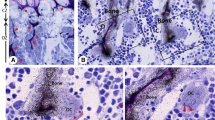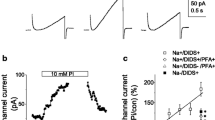Abstract.
Prostaglandins (PGs) are well known to be important local factors in regulating bone formation and resorption. PGE2 is a potent stimulator of bone resorption because of enhancing osteoclast formation by its indirect action through stromal cells. However, the direct action of PGE2 on functionally mature osteoclasts is still controversial. In this study using highly purified rabbit mature osteoclasts, we examined the direct effect of PGE2 on osteoclastic bone-resorbing activity and its mechanism. PGE2 inhibited resorption pit formation on a dentine slice by the purified osteoclasts in a dose- and time-dependent manner. The inhibitory effect appeared as early as 4 hours after the PGE2 addition. Forskolin and 12-0-tetradecanoyl phorbol-13-acetate (TPA), respective activators of adenylate cyclase and protein kinase C, also decreased the osteoclastic bone-resorbing activity. PGE2 increased the content of intracellular cAMP in a dose range effective for the inhibition of bone resorption, whereas the prostanoid did not alter the intracellular level of inositol triphosphate. The inhibition of osteoclastic bone resorption by PGE2 was amplified and diminished by a cAMP phosphodiesterase inhibitor (isobutyl methylxanthine) and a protein kinase A inhibitor (Rp-cAMP), respectively. Of four different subtypes of PGE2 receptors (EPs), EP4 mRNA was predominantly expressed in isolated osteoclasts, whereas the other types of EP mRNA were detected in only small amounts. These results suggest that the PGE2 inhibitory effect was mediated by an adenylate cyclase system coupled with EP4. This possible association of PGE2 with EP4 in mature osteoclasts was supported by the finding that a specific agonist of EP4 (AE-604) inhibited the bone-resorbing activity and elevated the intracellular cAMP content. However, butaprost, a selective EP2 agonist, also mimicked the PGE2 effects on isolated osteoclasts although EP2 mRNA expression was minimal. In conclusion, PGE2 directly inhibits bone-resorbing activity of functionally mature osteoclasts by activation of the adenylate cyclase system, perhaps mainly through EP4.
Similar content being viewed by others
Author information
Authors and Affiliations
Additional information
Received: 21 July 1999 / Accepted: 31 January 2000
Rights and permissions
About this article
Cite this article
Mano, M., Arakawa, T., Mano, H. et al. Prostaglandin E2 Directly Inhibits Bone-Resorbing Activity of Isolated Mature Osteoclasts Mainly Through the EP4 Receptor. Calcif Tissue Int 67, 85–92 (2000). https://doi.org/10.1007/s00223001102
Published:
Issue Date:
DOI: https://doi.org/10.1007/s00223001102




